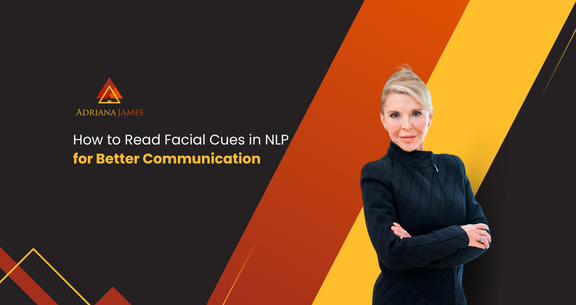By Dr Adriana James | NLP Master Trainer | Tad James Co.
How do you truly know what someone is feeling—even if they say nothing at all?
As you develop deeper observational skills through NLP, you begin to recognize that the body always tells the truth—you just have to know what to look for.
In this post, Dr. Adriana James explores two more often-overlooked physiological markers that reveal emotional and behavioral shifts:
- Lower lip changes
- ️ Eye focus and pupil dilation
If you’ve been following the series, you’ve already practiced noticing skin color, muscle tone, facial symmetry, and breathing. Now, you’re about to take your observational abilities to a whole new level.
1. Lower Lip Size: A Small Signal with Big Meaning
This isn’t about lip fillers or cosmetics. This is about blood flow and muscle relaxation.
When a person is in a relaxed emotional state, their lower lip appears fuller, smoother, and shows fewer fine lines. Why? Because:
- Relaxed muscles = more blood flow
- More blood flow = plumper lip tissue
- Tension or discomfort = retracted, tighter lips with more visible lines
What to Look For:
- Is the lower lip smooth and rounded, or tight with visible lines?
- Does it subtly retract during the conversation?
Pro Tip: Pay attention when the conversation shifts from a comfortable to an uncomfortable topic. Watch the lip change in real time. It’s one of the subtlest giveaways of emotional state—and few people know it even exists.
These micro-movements can offer real-time insights into a person’s comfort level — especially in coaching or negotiation contexts.
This subtle but powerful facial cue is often overlooked in mainstream body language training, making it a unique asset in sensory acuity for NLP practitioners.
2. Eye Focus & Pupil Dilation: The Truth is in the Gaze
You’ve heard that the eyes are the window to the soul. In NLP, they’re also a powerful calibration tool.
Tracking the eyes is one of the core methods for understanding unconscious shifts in state — especially when paired with other facial cues.
Eye Focus:
There’s a visible difference between focused eyes (direct, alert) and defocused eyes (relaxed, peripheral, or visualizing something internally).
How to Tell:
- Focused: Eyes are locked in and muscles around the eye are active.
- Defocused: Eyes soften slightly; gaze may “float” as the person looks inward or accesses memory or imagination.
Pupil Dilation:
This change happens involuntarily—and fast. Emotional responses like interest, arousal, fear, or surprise can all cause the pupils to:
- Dilate (enlarge) when someone is emotionally engaged or stimulated
- Constrict (shrink) when they feel threatened, anxious, or disengaged
Note: Lighting affects pupils too, so always calibrate within context. You’re looking for relative change, not absolutes.
In NLP, this type of awareness enhances how we measure emotional intensity during dialogue, even when external expressions remain neutral.
Real-World Examples & Application
Let’s say someone is telling you about a troubling event. You notice:
- Their lower lip tightens, showing more lines
- Their pupils constrict slightly
- Their eyes narrow and become more sharply focused
You now have a calibrated physiological pattern for this person’s experience of stress or discomfort.
Compare that to when they were talking about something enjoyable:
- Their breathing slowed
- Their face was more symmetrical
- Their lower lip looked full
- Their eyes were defocused or slightly dreamy
This ability to compare subtle cues over time is the cornerstone of effective calibration in NLP — and what separates expert communicators from those relying on assumption.
What to Practice This Week
For the next 2–3 days:
- Pay attention ONLY to lower lip changes (size, lines, tension)
- Then shift to eye focus and pupil dilation
- Do not assign meaning yet—just notice and compare
Pro tip: These are best observed in calm, 1:1 conversations. Try it at dinner, during meetings, or in casual chats with friends.
Keep a simple journal to reflect on what you notice — it sharpens awareness over time.
The Bigger Picture: Why This Matters
These advanced observational skills give you a real-time emotional radar. You’ll know when someone:
- Likes what they’re hearing
- Feels confused, disconnected, or resistant
- Is engaging with you—or just being polite
Instead of guessing, you’ll know—and that makes you a more effective communicator, leader, coach, or partner.
The result? More aligned conversations, faster rapport, and clearer outcomes — all without needing the other person to say a word.
Ready to Learn the Full System?
This skill isn’t magic. It’s trained. It’s taught. And it’s one of the first things you’ll master in our NLP Practitioner and Master Practitioner trainings.
✔ Spot hidden resistance before it sabotages a sale
✔ Know when a client is aligned with their goal—or secretly unsure
✔ Recognize when your message lands—and when to pivot
Join NLP Practitioner Training »
Step into Mastery with NLP Master Practitioner »
In a world where most people rely on surface-level cues, you’ll be reading what’s truly going on beneath them.

